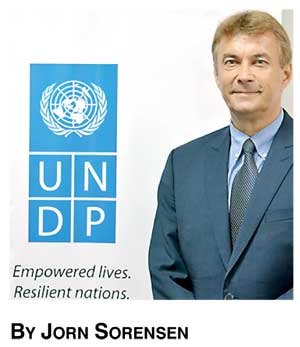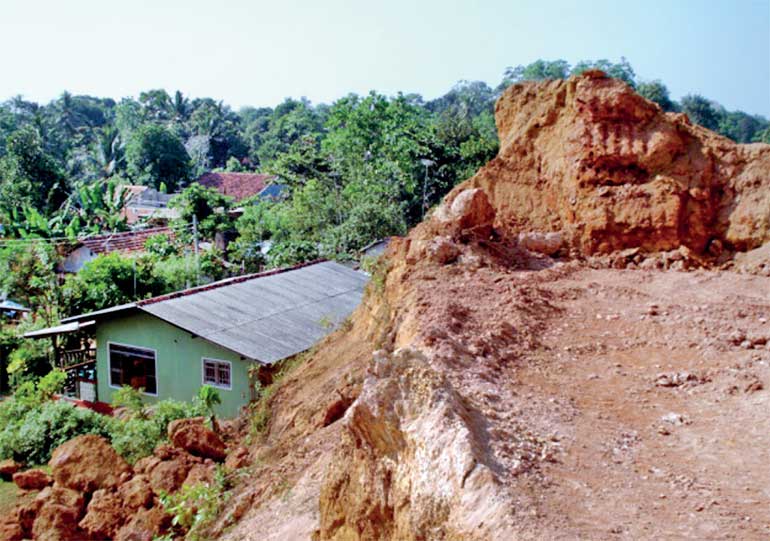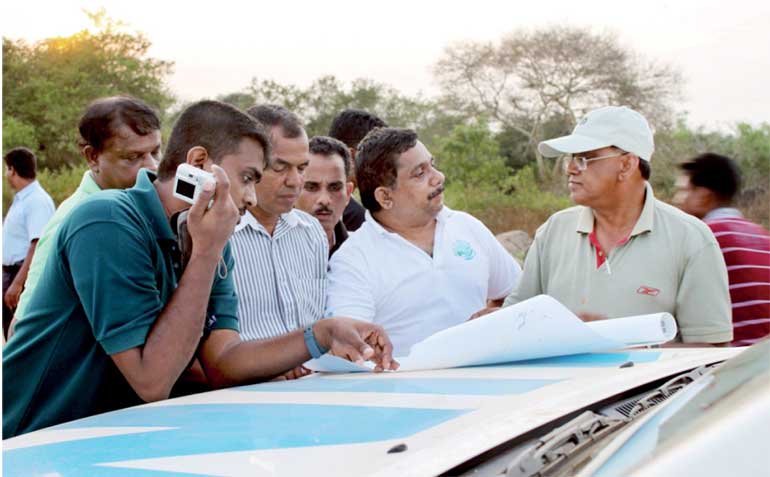Monday Mar 17, 2025
Monday Mar 17, 2025
Tuesday, 13 October 2015 00:12 - - {{hitsCtrl.values.hits}}
By Jorn Sorensen
All about choices
Being a tropical island nation with a population close to 23 million, Sri Lanka is exposed to a range of natural hazards which, combined with poor land use practices and the effect of climate change puts the country’s hard earned development gains at risk, threatening economic growth and poverty elevation efforts.
Disaster Risk Reduction (DRR) aims to reduce the risk of damage that can be caused by natural hazards through a system of  preventive processes and actions. The severity of these disasters depend on the choices we make, in relation to government policies, how we grow our food, where and how and where we build our homes, town and cities. Each decision either makes us more vulnerable to disasters or more resilient and so DRR is all about choices.
preventive processes and actions. The severity of these disasters depend on the choices we make, in relation to government policies, how we grow our food, where and how and where we build our homes, town and cities. Each decision either makes us more vulnerable to disasters or more resilient and so DRR is all about choices.
In spite of strengthened disaster management institutions and nation-wide early warning capabilities, the impact of disasters and climate change is creating new challenges for Sri Lanka. Even though the number of lives lost due to disasters has decreased over the years, there has been a significant increase in economic losses and damages to property. In the recent past the severity of landslides has increased in the central highlands, while emerging hazards such as lightning and high winds have also shown an increasing trend in the country.
UNDP, supporting national DRR initiatives
Minimising the impact of disasters has been a national priority for the past decade, since the December 2004 Indian Ocean tsunami. In the past, the Ministry of Disaster Management, together with other institutions under its purview and other stakeholder agencies have implemented a number of programmes in order to achieve DRR priorities in line with the Hyogo Framework for Action.
UNDP, making a conscious decision to support the Government’s initiatives, has been serving as the main development and technical partner in Disaster Management in Sri Lanka since its establishment with the support from other partners such as Australian Department of Foreign Affairs and Trade, Swedish International Development Cooperation Agency, USAID and the Governments of France, Japan and Korea.
As the development arm of the United Nations, UNDP’s support has also extended to develop the ‘Road Map towards a Safer Sri Lanka’, the country’s previous long term disaster management plan. Furthermore, the establishment of a dedicated Ministry for Disaster Management, the Disaster Management Act, the Disaster Management Policy and a landslide early warning systems and the hazard profiles, integrated strategic environmental assessment, guidelines for disaster resilient building construction, training materials for school children and a 30 year disaster event database (DesInventar) are a few of the remarkable achievements by the country, financially and technically supported by UNDP.
 Village at risk due to natural disasters
Village at risk due to natural disasters
What is SLCDMP?
More recently in 2012, UNDP supported the Ministry of Disaster Management to develop the ‘Sri Lanka Comprehensive Disaster Management Programme’ (SLCDMP) 2014-2018, a Programme which ensures the ‘safety of Sri Lanka’ by reducing potential disaster risks and impacts on the people, property and the economy. The programme was approved by the Cabinet of Ministers in July 2014 and subsequently by the Department of National Planning.
SLCDMP is designed as a multi-hazard, multi-sector, multi-agency and multi-stakeholder programme using the implementation experience of ‘Road Map Towards a Safer Sri Lanka (2005)’. While the Ministry of Disaster Management implements the SLCDMP, UNDP provides the overall coordinating facilitating and technical assistance for the SLCDMP through a Programme Management Unit established in the Ministry the National Disaster Management.
Innovation in DRR
SLCDMP has not missed innovations. Earlier this year, UNDP together with key partner agencies began prototyping an Unmanned Aerial Vehicle (UAV) to be used in emergencies to collect information for improved emergency response and assess disaster damages in disaster situations. In addition, UNDP is also supporting the National Building Research Organization to develop a landslide sensor to detect land movements to improve early warning during landslides.
DRR at the heart of sustainability
The SLCDMP will also be the key instrument of the Government to achieve the new Sendai Framework for Disaster Risk Reduction (SFDRR), which was endorsed by 189 countries, including Sri Lanka, in March 2015. UNDP is now working in collaboration with the Ministry of Disaster Management to align the SLCDMP with the SFDRR within the development framework in Sri Lanka.
Efforts to reduce the threat posed by natural and man-made hazards also received a fresh boost last month when world leaders adopted the Global Goals, a new global sustainable development agenda that aims to eradicate extreme poverty and people’s well-being, while protecting the environment. Six of these goals relate directly to DRR, recognising that reducing exposure and vulnerability of the poor to disasters is essential for sustainable poverty eradication, and underlining the importance of resilient infrastructure, improved urban planning, and climate adaption and ecosystem protection.
Hence, 2015 is a landmark year for climate resilience, DRR and disaster management. It is a year when Governments adopted the SFDRR and the Sustainable Development Goals and this will be followed by COP21, a global climate accord, in Paris this December.
 UNDP Staff engages with communities to discuss disaster risk strategies
UNDP Staff engages with communities to discuss disaster risk strategies
Celebrating International Day for Natural DRR
The focus of this year’s International Day for Disaster Reduction is on the traditional, indigenous and local knowledge which complement modern science and add to individual’s and societies’ resilience. For example, knowledge of early warning signals in nature can be vital to ensuring early action is taken to mitigate the impact of both slow and fast onset disasters such as droughts, heatwaves, storms and floods. Combined with scientific knowledge such as reports generated by meteorologists, local knowledge is vital for preparedness and can be passed on from generation to generation.
UNDP, working in Sri Lanka for close to five decades, stands committed to partner and work closely with Government and Non-Government, civil society and private sector stakeholders to share knowledge, best practices and science to strengthen the implementation of SLCDMP to build a more resilient Sri Lanka for both people and the planet. 2015 is indeed a global time for action, marking of the International day for Natural Disaster Risk Reduction is a good reminder for all Sri Lankans to rethink their choices and role in the environment and on DRR because Disaster Risk Reduction is all about choices!
(The writer is Country Director, UNDP Sri Lanka.)
Discover Kapruka, the leading online shopping platform in Sri Lanka, where you can conveniently send Gifts and Flowers to your loved ones for any event including Valentine ’s Day. Explore a wide range of popular Shopping Categories on Kapruka, including Toys, Groceries, Electronics, Birthday Cakes, Fruits, Chocolates, Flower Bouquets, Clothing, Watches, Lingerie, Gift Sets and Jewellery. Also if you’re interested in selling with Kapruka, Partner Central by Kapruka is the best solution to start with. Moreover, through Kapruka Global Shop, you can also enjoy the convenience of purchasing products from renowned platforms like Amazon and eBay and have them delivered to Sri Lanka.
Discover Kapruka, the leading online shopping platform in Sri Lanka, where you can conveniently send Gifts and Flowers to your loved ones for any event including Valentine ’s Day. Explore a wide range of popular Shopping Categories on Kapruka, including Toys, Groceries, Electronics, Birthday Cakes, Fruits, Chocolates, Flower Bouquets, Clothing, Watches, Lingerie, Gift Sets and Jewellery. Also if you’re interested in selling with Kapruka, Partner Central by Kapruka is the best solution to start with. Moreover, through Kapruka Global Shop, you can also enjoy the convenience of purchasing products from renowned platforms like Amazon and eBay and have them delivered to Sri Lanka.